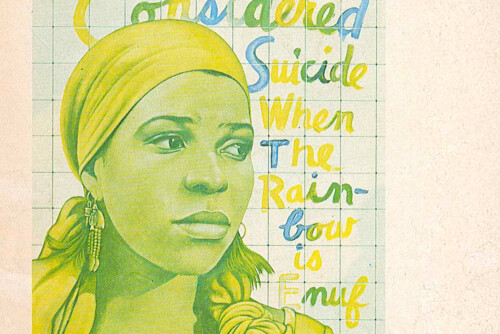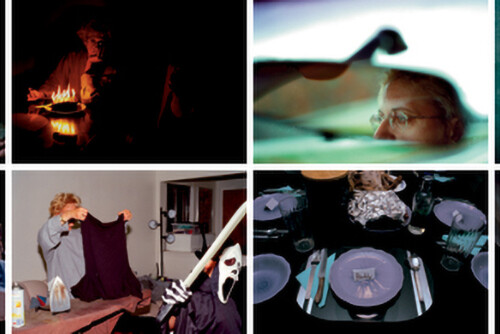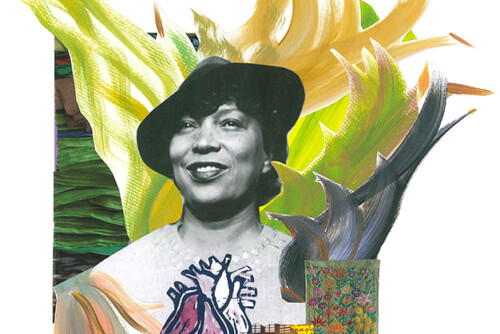In This Volume
This double issue of The Scholar & Feminist Online follows the organization of the initial Barnard conference. While we arranged the speakers into panels according to their specialties, each panel serendipitously focused on the two most acclaimed works in Shange’s expansive and varied canon: her 1982 novel, Sassafrass, Cypress and Indigo and, of course, for colored girls (1975). But the essays transcend these two texts, making profound interventions into the nature of Shange’s relationship to language, to the arts, and to the various worlds in which she moves and which inspired her work. The essays in Section One, “We are an interdisciplinary culture / we understand more than verbal communication,” put Sassafrass, Cypress and Indigo in dialogue with other Shange texts from nappy edges (1978) to if I can Cook, you Know God can (1998); they examine her poetics, her orthography, her insights into black cosmopolitanism and black genius, as well as her black feminist practice. So, too, the essays in Section Two, “a poetic possibility/ a poetic imperative: for colored girls,” revisit the impact of for colored girls, mapping the many ways the original choreopoem and the work it inspired cultivate black feminist community in resistance to the nation-state, narrow notions of the black diaspora, heteronormativity, and homophobia—both in the United States and worldwide.
Although Shange avers that she is “a poet in american theater,” rather than a playwright and evidences great distrust that “American Theater” as an institution can convey the truth and breadth of black lives, for colored girls has nonetheless moved into the canon of American theater.1 Section Three, “Moving our theater into the drama of our lives: Performing Shange” delves into the choreopoem’s transformation of people and space.
Shange’s “worldliness” and the impact of for colored girls bring up the issue of the universality of Shange’s art, a question that becomes an unexpected through-line in this section. How does a work that speaks so vividly of Shange’s experiences of being a black woman in the Americas reach so many audiences that may only tangentially know of that experience? Shange, of course, comprehends this question in a specifically diasporic framework. In the essay “takin’ a solo/ a poetic possibility/ a poetic imperative,” from nappy edges, she argues that black poets carry a specific burden of speaking to “a black experience” that other artists do not: “we assume the poet to be the voice of everywhere we are not/ as opposed to bein ‘everything we are.’”2
Christine Cynn’s interviews with directors Wole Oguntokun and Mũmbi Kaigwa take up the question of how much for colored girls speaks across cultural contexts. While Kaigwa (who, like McCauley, performed in an original for colored girls production and provided artistic vision for a later one) sees it as “a very American play, very particular and specific to a particular era,” she notes how little the reaction had changed in the 25 years since her first experience of for colored girls: “It was almost sad, the things women were saying about the show were that they found it so . . . liberating . . . A lot of women said that they felt that it was they themselves who were telling the story.”3 Reflecting on her experiences performing Shange’s words and Eve Ensler’s The Vagina Monologues, Victoria Durden (BC’15), like Kaigwa, finds that it is the intensely personal nature of Shange’s work and its call for a communal response that produces the larger effect: “And herein lies the important distinction between feminist theatre that is purportedly ‘global’ and that which is specific and above all, ‘personal.’”
If Shange’s pen is a machete, her choreopoem has become a key tool in feminist and activist theater. Theater historian Pam Cobrin and actress Robbie McCauley contextualize for colored girls’ movement from Broadway into a campus feminist phenomenon, Cobrin in relationship to the establishment of campus “V-Days” with performances of The Vagina Monologues and McCauley in the context of serving as artistic director to a for colored girls performance at Boston College. In the video, Ntozake Shange on Stage and Screen, Soyica Diggs Colbert, Monica L. Miller, and Ntozake Shange discuss the appearance of the Tyler Perry directed film, For Colored Girls and Shange, for the first time, speaks openly of her feelings about the movie.
Section Four: “lotsa body and cultural heritage: Shange’s legacy” includes materials that give newcomers to Shange important contexts for her work and its impact. Our conference speakers generously agreed to individual interviews while on campus, and BCRW creative director Hope Dector turned these inspiring meetings into two short videos. Her Pen is a Machete: The Art of Ntozake Shange offers a sense of Shange’s multiple political and poetic interventions—from the punctuation on the page, to the healing power of gesture, to the creation of space for powerful untold stories of trauma and transformation. Moving Across Disciplines and Genres: Teaching Shange gives strategies for teaching and interpreting Shange, helping students see how the page itself is performative and the necessity of bringing all of one’s senses to the reading experience. The final videos are taken from the conference: the conversation between Dianne McIntyre and Shange gives insight into Shange’s collaborative practice and the student showcase, performed for Shange at Barnard, is just one example of how students both perform from Shange’s oeuvre and create work inspired by her example.
Vani Natarajan, Barnard’s research and instructional services librarian for humanities and area studies, was an active member of the “Worlds of Shange” faculty seminar and generously compiled the “Recommended Reading and Online Resources” page, which includes both significant scholarly works and archival sources for future research.
These past 40 years have released the true spirit of inclusivity in for colored girls, in ways that are perhaps surprising to those who witnessed the initial controversy over the place of black men in the choreopoem (a controversy so virulent Shange avoids speaking about it in public even now). Stacey Muhammad’s interview with Gabrielle Davenport (BC ’15) hits on something we found throughout our research: the space the choreopoem creates for communities not composed of black women to tell their own stories. for colored girls is the guiding force behind Muhammad’s web series, For Colored Boys: Redemption, which tells the stories of incarcerated men in the free world and the communities who support them.
The Scholar & Feminist Online has been a notable platform for producing groundbreaking feminist scholarship and nurturing feminist pedagogy. We feel this pedagogical commitment is especially important as we continue to explore Shange’s legacy on stage, in the archive, and in classrooms—particularly now that the choreopoem for colored girls was revived (and somewhat overtaken) by the 2010 Tyler Perry film.
This double issue is launching at a time when Shange’s accomplishments and legacy are being recognized and preserved at Barnard and in the world. In 2013, Shange also donated papers, artworks, and books to the Barnard College Archives; students are now engaged in a yearlong course and multiyear digital humanities project on Shange and her influence. With this issue and archive, we have the opportunity for scholars and students to research and communicate the material connections of Shange’s work to second-wave feminist, black feminist, black arts, black power, Nuyorican poetry, and Civil Rights movements as well to the emerging field of Childhood Studies.
Characteristically turning complexity into creativity, Shange has said “the fact that we are an interdisciplinary culture /that we understand more than verbal communications / lays a weight on afro-american authors that few others are lucky enough to have been brought into.”4 This “burden” has resulted in a body of work that functions as a portal to other worlds, past, present, future, and internal, that “sings a black girl’s song,” in countless artistic, emotional, and political registers.
Acknowledgments: This volume was truly a collaborative venture involving many members of the Barnard College community. In addition to Mariel Rodney, our discerning and resourceful production assistant; our contributors; and The Scholar & Feminist Online production team, the editors would like to thank: Megan Cunnane (BC ’16), Thulani Davis (BC ’70), David Hopson, Kathryn McLean, Shannon O’Neill, Miriam Neptune, Sarah Pasadino, Quandra Prettyman, Paul Scolieri, Claude Sloan, Jr., Souleo, Martha Tenney, Nicci Yin, Megan Wacha, the faculty in Africana Studies and CCIS, the wonderful staff of the Barnard Center for Research on Women (BCRW), members of the Willen Faculty seminar, the students in the first “The Worlds of Ntozake Shange” seminar, the Provost’s Office at Barnard College and, of course, Zake.
- Ntozake Shange, “unrecovered losses/ black theater traditions,” lost in language & sound or how I found my way to the arts: essays (New York: St. Martin’s Griffin, 2011) 13-17. [↩]
- Shange, lost in language & sound 2011: 5. [↩]
- Interestingly, this cry for response is a key part of black feminist poetics and Kaigwa (this issue) mentions that it was the African American women in the Nairobi audience who “talk[ed] back” to the performance and responded viscerally, in contrast to the Kenyans who have a more English response to performance in a formal theater space. [↩]
- Shange, lost in language & sound 2011: 16. [↩]



